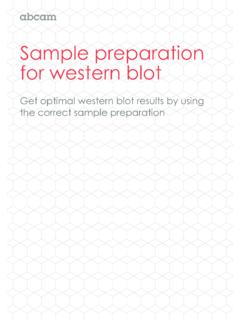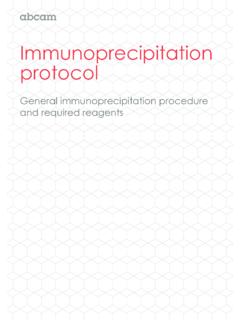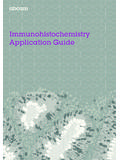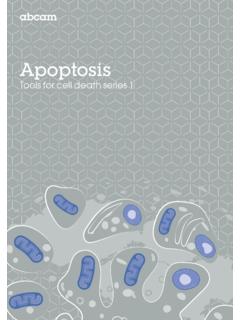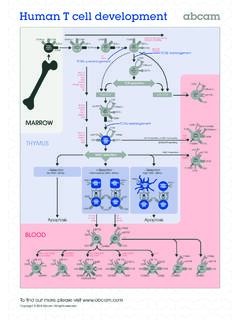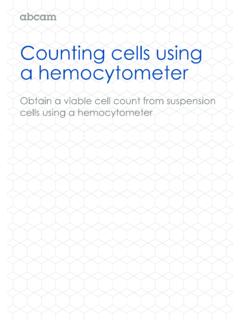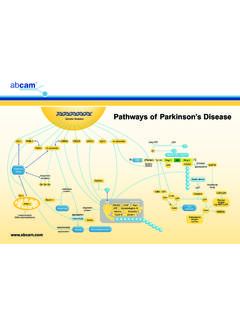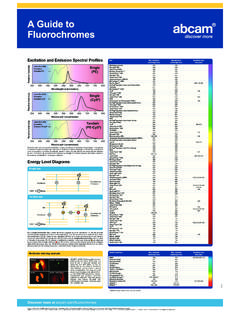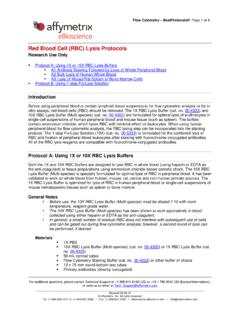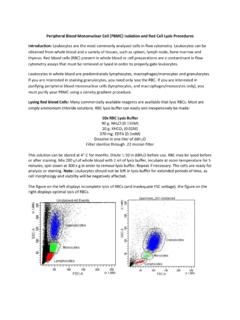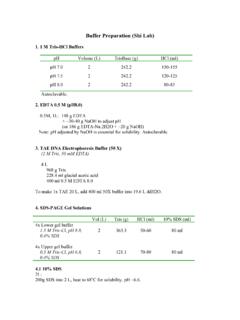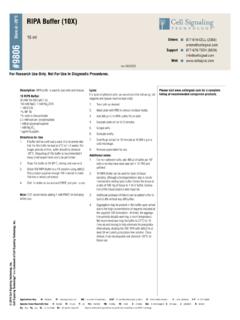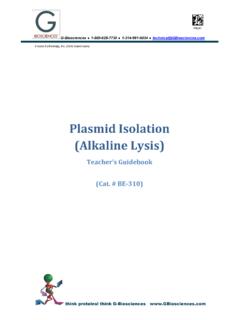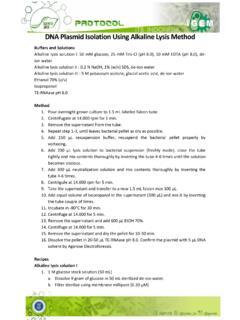Transcription of Sample preparation for western blot - Abcam
1 Sample preparation for western blot Get optimal western blot results by using the correct Sample preparation 2 Sample preparation for western blot Contents lysis buffers Protease and phosphatase inhibitors preparation of lysate from cell culture preparation of lysate from tissues Determination of protein concentration preparation of samples for loading into gels lysis buffers lysis buffers differ in their ability to solubilize proteins, with those containing sodium dodecyl sulfate (SDS) and other ionic detergents considered to be the harshest and therefore most likely to give the highest yield. The main consideration when choosing a lysis buffer is whether the chosen antibody will recognize denatured samples. When this is not the case, it will be noted on the antibody datasheet, and buffers without detergent or with relatively mild non-ionic detergents (NP-40, Triton X-100) should be used.
2 Protein location and lysis buffer choice Protein location buffer recommended Whole cell NP-40 Cytoplasmic (soluble) Tris-Triton Membrane bound NP-40 or RIPA Nuclear RIPA or use nuclear fraction protocol* Mitochondria RIPA or use mitochondrial fraction protocol* *Proteins that are found exclusively or predominantly in a sub-cellular location will be more enriched in a lysate of the sub-cellular fraction compared with whole cell or tissue lysates. This can be useful when trying to obtain a signal for a weakly-expressed protein. Please consult our separate protocols for sub-cellular fractionation. 3 lysis buffer recipes NP-40 buffer 150 mM sodium chloride NP-40 (Triton X-100 can be substituted for NP-40) 50 mM Tris pH This is a popular buffer for studying proteins that are cytoplasmic or membrane-bound, or for whole cell extracts.
3 If there is concern that the protein of interest is not being completely extracted from insoluble material or aggregates, RIPA buffer may be more suitable as it contains ionic detergents that will more readily bring the proteins into solution. RIPA buffer (radioimmunoprecipitation assay buffer ) 150 mM sodium chloride NP-40 or Triton X-100 sodium deoxycholate* SDS (sodium dodecyl sulfate) 50 mM Tris, pH *can be prepared as a 10% stock solution, which must be protected from light. RIPA buffer is useful for whole cell extracts and membrane-bound proteins, and may be preferable to NP-40 or Triton X-100-only buffers for extracting nuclear proteins. It will disrupt protein-protein interactions and may therefore be problematic for immunoprecipitations and pull-down assays. In cases where it is important to preserve protein-protein interactions or to minimize denaturation, a buffer without ionic detergents (eg SDS) and ideally without non-ionic detergents (eg Triton X-100) should be used.
4 Cell lysis with detergent-free buffer is achieved by mechanical shearing, often with a Dounce homogenizer or by passing cells through a syringe tip. In these cases, a simple Tris buffer will suffice, but as noted above, buffers with detergents are required to release membrane- or cytoskeleton-bound proteins. Tris-HCI buffer 20 mM Tris-HCl, pH Tris-Triton buffer (cytoskeleton proteins) 10 mM Tris, pH 100 mM NaCl 1 mM EDTA 1 mM EGTA 1% Triton X-100 10% glycerol SDS deoxycholate All four of these buffers will keep at 4 C for several weeks or for up to a year if divided into aliquots and stored at -20 C. 4 Sample preparation for western blot Protease and phosphatase inhibitors As soon as lysis occurs, proteolysis, dephosphorylation and denaturation begin. These events can be slowed down significantly if samples are kept on ice or at 4 C at all times and appropriate inhibitors are added fresh to the lysis buffer .
5 Ready-to-use cocktails of inhibitors from various suppliers are available but you can make your own cocktail. Inhibitor Protease/phosphatase inhibited Final concentration in lysis buffer Stock (store at -20 C) Aprotinin Trypsin, chymotrypsin, plasmin 2 g/mL Dilute in water, 10 mg/mL. Do not re-use thawed aliquots. Leupeptin Lysosomal 5 10 g/mL Dilute in water. Do not re-use thawed aliquots. Pepstatin A Aspartic proteases 1 g/mL Dilute in methanol, 1 mM. PMSF Serine, cysteine proteases 1 mM Dilute in ethanol. You can re-use the same aliquot. EDTA Metalloproteases that require Mg2+ and Mn2+ 5 mM Dilute in dH20, M. Adjust pH to EGTA Metalloproteases that require Ca2+ 1 mM Dilute in dH20, M. Adjust pH to Sodium fluoride Serine-threonine phosphatases 5 10 mM Dilute in water. Do not re-use once defrosted. Sodium orthovanadate Tyrosine phosphatases 1 mM Dilute in water.
6 Do not re-use once defrosted. 5 Sodium orthovanadate preparation Perform all steps in a fume hood. 1. Prepare a 100 mM solution in double distilled water. 2. Set pH to with HCl. 3. Boil until colorless. Minimize volume change due to evaporation by covering loosely. 4. Cool to room temperature. 5. Set pH to again. 6. Boil until colorless. 7. Repeat this cycle until the solution remains at pH after boiling and cooling. 8. Bring up to the initial volume with water. 9. Store in aliquots at -20 C. Discard if samples turn yellow. preparation of lysate from cell culture 1. Place the cell culture dish on ice and wash the cells with ice-cold PBS. 2. Aspirate the PBS, then add ice-cold lysis buffer (1 mL per 107 cells/100 mm dish/150 cm2 flask; mL per 5x106 cells/60 mm dish/75 cm2 flask). 3. Scrape adherent cells off the dish using a cold plastic cell scraper, then gently transfer the cell suspension into a pre-cooled microcentrifuge tube.
7 Alternatively cells can be trypsinized and washed with PBS prior to resuspension in lysis buffer in a microcentrifuge tube. 4. Maintain constant agitation for 30 min at 4 C. 5. Centrifuge in a microcentrifuge at 4 C. You may have to vary the centrifugation force and time depending on the cell type; a guideline is 20 min at 12,000 rpm but this must be determined for your experiment (eg leukocytes need a very light centrifugation). 6. Gently remove the tubes from the centrifuge and place on ice, aspirate the supernatant and place in a fresh tube kept on ice. Discard the pellet. 6 Sample preparation for western blot preparation of lysate from tissues 1. Dissect the tissue of interest with clean tools, on ice preferably, and as quickly as possible to prevent degradation by proteases. 2. Place the tissue in round-bottom microcentrifuge tubes or Eppendorf tubes and immerse in liquid nitrogen to snap freeze.
8 Store samples at -80 C for later use or keep on ice for immediate homogenization. 3. For a ~5 mg piece of tissue, add ~300 L of ice cold lysis buffer rapidly to the tube, homogenize with an electric homogenizer, rinse the blade twice with another 2 x 300 L lysis buffer , then maintain constant agitation for 2 h at 4 C (eg place on an orbital shaker in the fridge). Volumes of lysis buffer must be determined in relation to the amount of tissue present. Protein extract should not be too diluted to avoid loss of protein and large volumes of samples to be loaded onto gels. The minimum recommended concentration is mg/mL, optimal concentration is 1 5 mg/mL). 4. Centrifuge for 20 min at 12,000 rpm at 4 C in a microcentrifuge. Gently remove the tubes from the centrifuge and place on ice, aspirate the supernatant and place in a fresh tube kept on ice.
9 Discard the pellet. Determination of protein concentration 1. Perform a Bradford assay, a Lowry assay or a bicinchoninic acid (BCA) assay. Bovine serum albumin (BSA) is a frequently used protein standard. 2. Once you have determined the concentration of each Sample , you can freeze them at -20 C or -80 C for later use or prepare for immunoprecipitation or for loading onto a Sample preparation for western blot preparation of samples for loading into gels Denatured, reduced samples Antibodies typically recognize a small portion of the protein of interest (referred to as the epitope) and this domain may reside within the 3D conformation of the protein. To enable access of the antibody to this portion it is necessary to unfold the protein, ie denature it. To denature, use a loading buffer with the anionic detergent sodium dodecyl sulfate (SDS), and boil the mixture at 95 100 C for 5 min.
10 Heating at 70 C for 5 10 min is also acceptable and may be preferable when studying multi-pass membrane proteins. These tend to aggregate when boiled and the aggregates may not enter the gel efficiently. The standard loading buffer is called 2X Laemmli buffer (Laemmli UK, 1970. Cleavage of structural proteins during the assembly of the head of bateriophage T4. Nature, 227, 680 5). It can also be made at 4X and 6X strength to minimize dilution of the samples. The 2X is to be mixed in 1:1 ratio with the Sample . 2X Laemmli buffer recipe 4% SDS 10% 2-mercaptothanol 20% glycerol bromophenol blue M Tris HCl Check the pH and bring it to pH When SDS is used with proteins, all of the proteins become negatively charged by their attachment to the SDS anions. SDS binds to proteins fairly specifically in a mass ratio of :1. In doing so, SDS confers a negative charge to the polypeptide in proportion to its length.
